7 Examples of Location-Based Services Apps
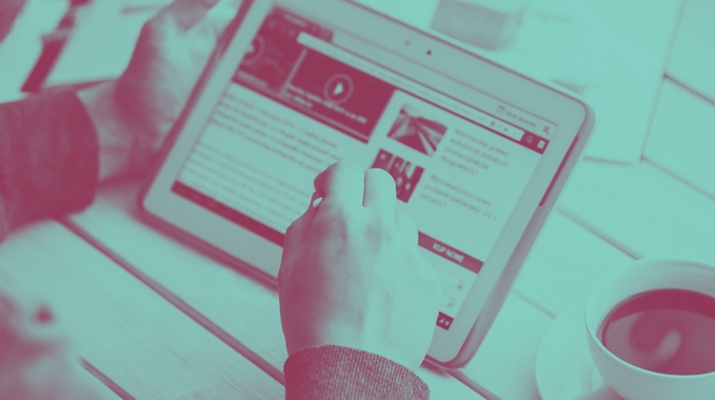
7 Examples of Location-Based Services Apps
More and more, companies integrate location-based services into their mobile apps. This article will look at some of the best mobile apps that use these features and examine the future of location-based mobile apps, especially in the wake of growing privacy concerns.
Updated 08/05/2022
An old saying says that the key to making it through life is to know where you are, where you’ve been, and where you’re going. In today’s digital world, there is an app for that.
Whether you want to let others track your movements, find or get to someplace, or simply know your current location and what is around you, apps featuring location-based services (LBS) can help. However, this assistance comes with a cost. LBS apps track—and share—more of your data than you may be aware.
This article will take a look at 7 great examples of LBS apps available today, as well as explore what LBS mobile technology will look like in the years ahead, particularly as users attempt to take back their privacy.
Location-Based Services: From Simple Beginnings to User Reliance
Many believe that LBS apps only appeared in the past few years. In truth, LBS technology emerged at the end of the last millennium.
Starting in the late 1990s, LBS apps resulted from the convergence of three different technologies: mobile internet access, global positioning, and advanced graphic interfaces.
Fast forward to today and you find that the number of LBS mobile users has steadily increased over the past several years.
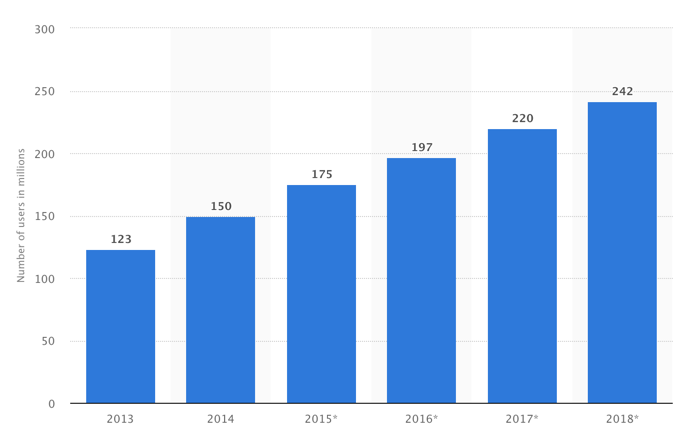
As smartphones become increasingly sophisticated and versatile, many Americans have increased their usage—and dependency—on the devices:
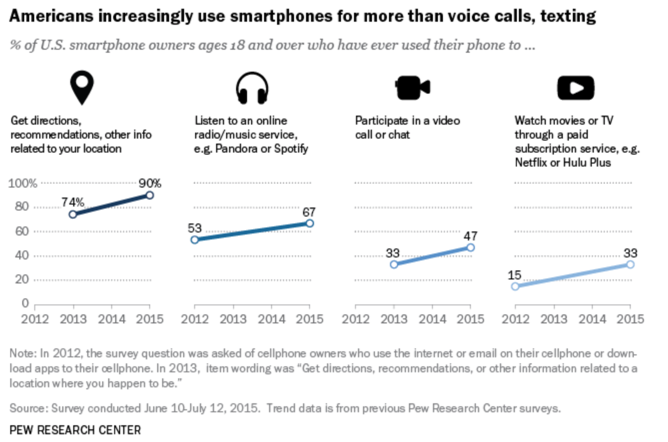
The LBS technology market is segmented into several different application uses:
- Navigation
- Search and advertising
- Infotainment
- Tracking
- Games and augmented reality
Research from Kantar TNS shows that navigation is the most popular type of LBS app (46%), followed by finding restaurants (26%), finding friends nearby (22%), checking public transportation (19%), and receiving special deals or offers from retailers (13%).
A recent survey by The Manifest confirms that LBS navigation has become a staple for more than three-quarters of mobile users, with Google Maps being the overwhelming choice for mobile users. That preference stems from Google Maps’ extensive data and attention to detail, among other reasons.
How Do LBS Applications Work?
Especially popular for social networking apps on mobile phones, location services provide end users with key benefits by using location information. But how does having a customer location lead to better services? Here’s how it works.
For any LBS app to work, the following four elements need to be in place:
- An app capable of using location tracking data
- A global positioning system (GPS), another geospatial system, or short-range positioning beacons for location triangulation (requires Wi-Fi access)
- A mobile network able to receive data and transmit mobile location
- A server with analytics and information services capable of delivering localized data to smartphones based on their precise location
A device location is pinpointed through the use of the following tools:
- Wi-Fi data
- Cell tower information
- QR codes scans
- RFID (radio frequency identification) technology
- Bluetooth technology
Service providers can use these tools and the process above to offer more interactive experiences through localization and collecting geographical location information.
7 Great Location-Based Services Apps (That Aren’t Google Maps)
While Google Maps sets the bar for LBS navigation, several other LBS apps demonstrate just how far the technology has come to provide users with amazing location-based experiences.
Here are top examples of location-based services apps:
Looking for help implementing LBS into your app idea? Connect with an expert app development firm on The Manifest.
1. Foursquare
Foursquare was an LBS app innovator, popularizing the idea of checking into locations through a mobile device (a use that has been replicated by numerous other apps, such as Facebook and Yelp).
Today, Foursquare technically offers two versions of itself. Foursquare continues to be a location-aware smart search tool that focuses on finding nearby locations, events, restaurants and shops. Meanwhile, the Swarm app, launched by Foursquare in 2014, is used for checking in and sharing locations with friends.
The two versions are often used in tandem. Foursquare helps the user find nearby places that fit his/her interests, such as a type of restaurant or activity, while Swarm helps the user invite friends to join by broadcasting the user’s location to his/her Foursquare/Swarm contacts. The user can also meet up with friends by quickly seeing which contacts are nearby.
Foursquare/Swarm are free for both Android and iOS devices.
2. Dark Sky
Weather apps are “a dime a dozen,” but Dark Sky uses LBS technology to provide a truly unique experience. Unlike its competitors, Dark Sky goes deeper than a simple high-level forecast summary. It offers hyperlocal forecasts for an exact address, with down-to-the-minute notifications about changing weather conditions.
Dark Sky aggregates weather data from various sources, combining multiple weather models and data to determine the most accurate weather prediction. It offers a “next hour” weather graph, a detailed 24-hour forecast, and a beautifully designed seven-day outlook. Dark Sky also constantly updates the “next hour” forecast, highlighting when weather conditions will change (e.g., when it will stop/start raining).
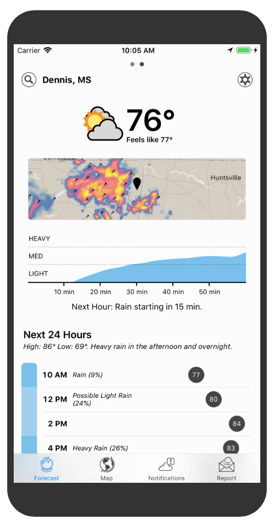
Dark Sky is free for Android (with in-app purchases available) and costs $3.99 for iOS.
3. Pokémon Go
When this app first launched, several viral videos of people doing silly things while searching for Pokémon characters (such as falling into bodies of water or walking into buildings) proliferated. Since then, the craze has cooled a bit, but this LBS app remains a mobile gaming hit, combining the addictive rush of collecting creatures and battling monsters with augmented reality technology.
Players use the app to explore their surroundings on foot, using the smartphone as a map and viewfinder to discover and collect Pokémon characters. If a user joins one of the game's three factions, the user can battle others for control of a location-based Pokémon Gym.
Each place in the app is tied to real-world locations that the user has to visit physically, encouraging players to travel to collect more characters and visit new neighborhoods.
Pokémon Go is free for Android and iOS, though the game offers in-app purchases.
4. Curbside
LBS apps are changing the way people shop. Many consumers (who don’t flock to Amazon) prefer to order, pick up, and go. No more waiting in long lines, hunting through aisles, or wasting time looking for parking.
On Curbside, the process is as follows: the user places an order online, the retailer or restaurant fills the order, the customer gets an alert that the order is ready, the retailer/restaurant gets an alert when the customer arrives, and an employee carries the order out to the customer.
The Curbside app brings this unique shopping/ordering experience to many U.S. cities. Curbside works with several leading retailers (Best Buy, Nordstrom, Sephora, CVS Pharmacy) and restaurants (Pizza Hut, Chipotle Mexican Grill, Boston Market) to make shopping quick, easy, and relatively painless. However, store choices in a particular area may be limited.
Curbside is free for Android and iOS.
5. Target
Not to be outdone by an external service, Target incorporated LBS technology to transform the mobile user experience.
For example, the retailer’s "Drive Up" curbside pickup program, which is slowly rolling out nationwide, allows users to order items from a Target store of choice, select “Drive Up” in the checkout options, and pick up the order at the curb instead of entering the store. The app sends a notification when the order is ready for pickup.
The LBS technology within the app tracks the user’s location en route to the designated parking spot, ensuring that a Target associate is waiting for the order when the user arrives. This makes shopping at Target quicker for the user, and potentially less expensive by foregoing the “impulse buys” that typically find their way into your shopping cart.
The Target app is free for Android and iOS.
6. Gas Buddy
Drivers in the United States and Canada are always on the lookout for the cheapest nearby gas prices, and the GasBuddy mobile app uses LBS technology and user inputs to aid in that quest.
GasBuddy connects drivers to a database of more than 150,000 gas stations and convenience stores, providing real-time fuel price information, station locations and offerings, and ratings/reviews. Data is provided by users, stations, and relationships with credit card companies. However, since many of the reported prices are based on user reports, GasBuddy rewards users with points for reporting and updating fuel prices.
GasBuddy also offers a payments service, Pay with GasBuddy, that entitles drivers to save on every gallon of gas they pump.
GasBuddy is available for free on Android and iOS.
7. Uber
No matter the reason—going out on the town without worrying about drinking and driving, getting around in an unfamiliar area, or avoiding the problems of searching/paying for a parking spot—Uber is a popular choice for transportation today. And the Uber app is a prime example of using LBS technology to provide a more user-friendly experience.

The Uber ridesharing app allows users to request a ride and pay with a credit/debit card (or cash in select cities). The app uses two-way LBS technology so the driver knows where to pick up the user, and the user can see a live view of the driver’s location on a map.
The Uber app also provides two-way communication between the user and driver. For example, the user can describe the driver (e.g., “I am wearing a red hat”), and the driver can let the user know if there is a delay (e.g., “Traffic is stopped—be there soon”).
Finally, the app gives the user the chance to rate the driver and experience, and those ratings can be helpful for other users.
Uber is available for free on Android and iOS.
Privacy Remains a Concern
While LBS apps increasingly become part of our reality, many see them as an affront to our personal liberty.
LBS technology enriches our mobile experiences, but at the same time, it raises a major concern about privacy, since service providers are capable of continuously tracking a user’s location.
According to an independent consumer study commissioned by Skyhook, 83% percent of app users say location is crucial to their app experiences, but nearly 40% are hesitant to share their location.
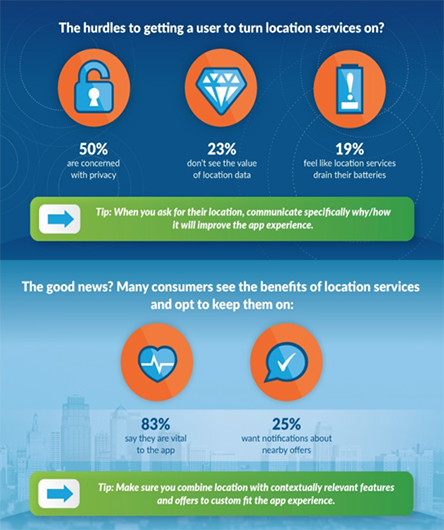
Users expect real benefits from LBS apps in exchange for disclosing their location. Nearly half of all app users expect an accurate location, relevant app content, and targeted offers or coupons once location data is shared. Meanwhile, more than a third of smartphone users expect personalized communications in exchange for enabling LBS app functionality.
The information available through LBS technology goes well beyond personal privacy. For instance, law enforcement often makes the case for using LBS apps to track criminals and terrorists, but does that legitimate using that data for unauthorized purposes?
Mobile devices now allow the user to adjust the LBS settings individually for each app (e.g., only turning on location-based services when the app is in use), which may alleviate some of the privacy concerns accompanying LBS app usage.
With that said, the responsibility still falls on the app developers to keep users’ data private, a task that will focus on infrastructure and hack prevention.
Read More: Apple Maps vs. Google Maps
The Future of LBS Mobile Technology
As we become more accustomed to our smartphones, the future of LBS apps will change. These apps are reaching well beyond the “check in” abilities of Foursquare and Facebook, and well past using Google Maps to guide you to your destination.
Geofencing, in-store mapping, and location-based advertisements have all recently seen their time to shine. These marketing and user experience initiatives all have a bright future ahead of them as more businesses, retailers, restaurants, and service providers adopt LBS technology into their mobile apps. LBS features will allow businesses to provide relevant content and improve a user’s in-app experience.
From “going” to gaming, and from ordering to consuming, LBS technology improves the functionality of many mobile apps. Without these LBS features, most of the mobile apps available today would not be as widely downloaded and used as they are.
Connect with the best app development companies on The Manifest.
